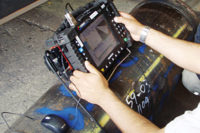A study released in January by Princeton University economists Alan Krueger and Alexandre Mas looks at multiple sources of public data on failed Firestone tires. The tires have been linked to 271 fatalities, many occurring when Ford Explorer sport utility vehicles rolled over following tire-tread separation.
Firestone recalled 6.5 million 15-inch AT, ATX and ATX II tires in August 2000. The company has acknowledged that a disproportionate number of problem tires came from Decatur, one of three plants that made most of the recalled tires. Firestone cites "certain manufacturing factors" at Decatur among several contributing causes for the tread separations, but maintains that labor strife was not a factor.
Labor discord flared at Decatur after Bridgestone, Firestone's Japanese parent, demanded concessions from the union in January 1994, including a move from 8-hour workshifts to rotating, 12-hour, day-and-night shifts. When the union struck in July 1994, the company hired lower-wage replacement workers. The union eventually capitulated, ending its strike in May 1995, and union members began returning at reduced pay to work 12-hour shifts alongside replacement workers. The dispute continued until December 1996, however, when a final contract was signed.
Using statistical techniques, Krueger and Mas analyzed data on tires made between January 1991 and March 2000. The numbers show significantly higher failure rates for tires made in Decatur from 1994 through 1996, during the labor dispute, than for tires made in more tranquil times before or after the dispute. Further, "tires that were made in Decatur during the labor dispute were eight times more likely to have a tread separation claim than were tires manufactured in other plants," the report says.
Some have hypothesized that undertrained replacement workers or lax supervision during the strike contributed to the tire defects. But the Princeton study suggests otherwise. Interestingly, the Krueger-Mas analysis shows a spike in the number of problem tires produced in the first half of 1994, around the time when the company demanded concessions, and again from the end of 1995 through the first half of 1996, when large numbers of replacement workers and returning strikers worked side-by-side. "It appears likely to us that something about the chemistry between the replacement workers and recalled strikers, or the cumulative impact of labor strife in general, created the conditions that led to the production of many defective tires," says the report.
No matter what caused the problems at Decatur--and there were likely many contributing factors--the Princeton study (available at www.irs.princeton.edu) is certain to make interesting reading for quality professionals. And it may serve as a useful reminder for management: Don't forget the human factor.
